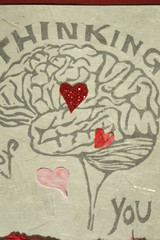 Happy birthday Synap! I hope you have a great day and a wonderful year.
Happy birthday Synap! I hope you have a great day and a wonderful year.
Sunday, April 22, 2012
Thursday, April 19, 2012
High Five Day

Apparently, it's National High Five Day in the US, which is a good excuse to raise money for cancer research. If you'd like to follow suit on this side of the border, the Canadian Cancer Society is here.
Things for which I have earned a high five this week include successfully making machines talk to me, figuring out how to get the water account switched to our names at the new house without sliping into a coma while on hold, and convincing financial institutions to shift my money around (to make the downpayment) without having my BC driver's license (since that was confiscated when I returned to Ontario and requested an Ontario driver's license). Catch-22 avoided, red tape defeated, digital insubordination outfoxed - yay!
In totally unrelated news, I am amused that The Olympics Daily (which must use a bot to gather tweets and be an aggregator) has mistaken my mentioning the The Handmade Olympics for a 'top story' about the 2012 London Games.
You still have some time to vote, by the way, and you can find Event 2 here and Event 6 here.
Labels:
bureaucracy,
cancer fundraiser,
handmade Olympics,
high five,
machines,
Olympics,
raccoon
Tuesday, April 17, 2012
Shortlisted! for the Handmade Olympics
So, remember the Handmade Olympics hosted by the lovely k. of the rikrak studio blog? Well, the shortlists are finally in! And TWO of my items have made the shortlists!
In event 2 Our Favorite Handmade Goodie for Kids" my Malayan Tapir Stuffies Set (mushrooms and butterflies flavour) is in the running:

In event 6 Our Favorite Handmade or Vintage Item That's Fun" my Oh nuts - Chipmunk linocut is in the running:
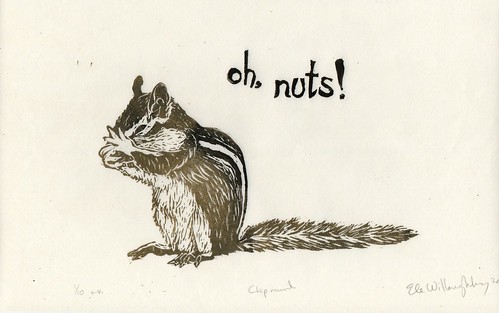
I hope you'll check out the lovely items shortlisted (& vote for me!); you can see everything here (and by following the links to each event
I was happy to see that some of the other handmakers I notimated made their respective shortlists, including the D.A.D. project for Event 5 (niceness through handmaking). You'll recall Emily and Serena sell art (theirs, and donated) to raise money for the Canadian Cancer Society. They are awesome and got my vote.
Do check out all the lovely items and blogs and be sure to cast your votes before Friday April 27th at 11:59 EST.
In event 2 Our Favorite Handmade Goodie for Kids" my Malayan Tapir Stuffies Set (mushrooms and butterflies flavour) is in the running:

In event 6 Our Favorite Handmade or Vintage Item That's Fun" my Oh nuts - Chipmunk linocut is in the running:

I hope you'll check out the lovely items shortlisted (& vote for me!); you can see everything here (and by following the links to each event
I was happy to see that some of the other handmakers I notimated made their respective shortlists, including the D.A.D. project for Event 5 (niceness through handmaking). You'll recall Emily and Serena sell art (theirs, and donated) to raise money for the Canadian Cancer Society. They are awesome and got my vote.
Do check out all the lovely items and blogs and be sure to cast your votes before Friday April 27th at 11:59 EST.
Labels:
2012 Handmade Olympics,
charity,
chipmunk,
friends,
linocut,
Malayan tapir,
printmaking,
stuffed animal
Monday, April 16, 2012
1400 Hearts!
 So, if you follow this blog, you'll know how much I love seeing new hearts for my shop. So I really am happy to see today that I've got 1400! Thanks to every single one!
So, if you follow this blog, you'll know how much I love seeing new hearts for my shop. So I really am happy to see today that I've got 1400! Thanks to every single one! ♥ minouette
Wednesday, April 11, 2012
Narcomedusae Jellyfish Linocut
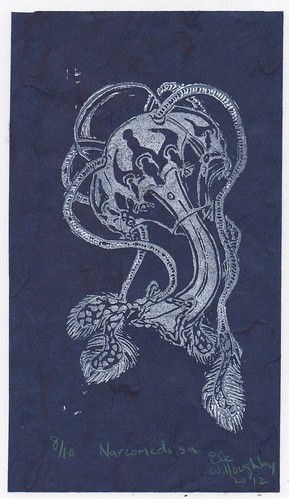
I made this dainty lino block print of a Narcomedusae order of jellyfish on beautiful handmade deep blue Japanese Chitose Gunjo paper with silk fibres which add to the organic feel of the piece and makes each print rather unique. Each print in this edition of 10, is 4.5 inches by 8 inches or 11.3 cm by 20.3 cm.
Jellyfish have such beautiful, fluid, organic lines. This seems to mirror the view of Ernst Haekel, the famed German biologist, naturalist, philosopher, physician, professor and artist (and influence on me), whose book "Art Forms in Nature" filled with lovely 19th century scientific illustrations of biology inspired my original drawing and then carving in linoleum of this creature. In fact, Haekel himself named this order of animals in 1879.
I've been wondering about their name. The discomedusa sounds like a medusa (as in jellyfish, rather than Μέδουσα the snake-headed Gorgon of Greek myth) boogieing on the dance floor, but of course, the "disco-" refers to its disk-like shape. "Narco-" means "numbness or torpor" rather than indicating that this jellyfish is somehow involved in the drug trade. Now, I don't know if these jellies are numb or torpid, or whether they sting (something which often leads to numbness). Haeckel's other medusas are the tracho- or tranchymedusa ("rough" medusa), leptomedusa ("thin, fine or slight" medusa), peromedusa ("malformed" medusa, ouch!), anthomedusa ("flower" medusa), stauromedusa ("cross", as in the shape rather than the mood, medusa), and cubomedusa (which are the box jellyfish). So now you know.
Labels:
Ernst Haeckel,
Japanese Chitose Gunjo paper,
jellyfish,
linocut,
linoleum,
minouette,
Narcomedusa,
printmaking,
washi
Wednesday, April 4, 2012
Wilhelm Roentgen's X-rays - A Thermochromic Linocut
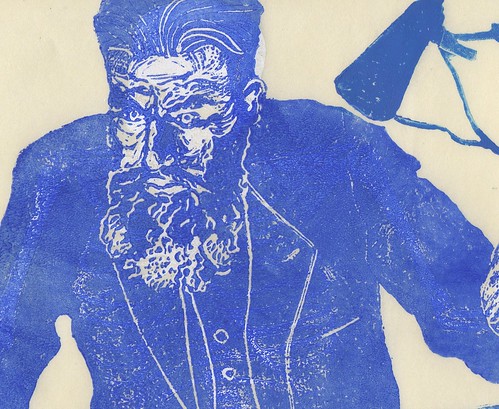

This is a colour-changing (!) block printed portrait of Wilhelm Röntgen (or Roentgen, without the umlaut), 1845-1923, the German physicist who discovered x-rays and earned the Nobel Prize for physics in 1901. I've depicted him at work, studying this mysterious, newly discovered, invisible form of light, based on a photograph of him in his lab, using a Crookes tube to produce x-rays. The form of the print mimics the nature of his discovery - much as x-rays reveal the skeleton within, the thermochromic ink in which Wilhelm Röntgen is printed dispears when heated to reveal his skeleton below! The lino block print is an edition of six (some variability in mixed colours) in white, cobalt blue and navy thermochromic ink on 9.25 inch by 12.5 inch (23.5 cm by 31.8 cm) Japanese kozo paper.
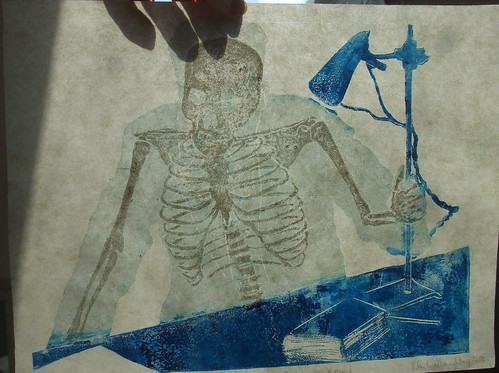
 Wilhelm Röntgen discovered X-rays using the Crookes tube in 1895. A Crookes tube is an early experimental electrical discharge tube, invented by English physicist William Crookes and others around 1869-1875, in which cathode rays, streams of electrons, were discovered. Despite his efforts to block the light from the tube with cardboard, during his experiments, he noticed that the invisible cathode rays (electrons) caused a fluorescent effect on a small cardboard screen painted with barium platinocyanide when it was placed close to the aluminium window in the tube. Some sort of light was passing through the opaque cardboard and Röntgen speculated that a new kind of ray might be responsible. He called these unknown rays 'x-rays'. We now know that x-rays can be produced when electrons strike a metal target, through a process called Bremsstrahlung* (or 'the braking of radiation'). During further tests of the interaction of these rays with metals, he saw the image of his own ghostly skeleton on the barium platinocyanide screen. Within two weeks he had taken the first x-ray photograph: an image of his wife Anna Bertha's hand, inventing the entire field of radiology and medical imaging!
Wilhelm Röntgen discovered X-rays using the Crookes tube in 1895. A Crookes tube is an early experimental electrical discharge tube, invented by English physicist William Crookes and others around 1869-1875, in which cathode rays, streams of electrons, were discovered. Despite his efforts to block the light from the tube with cardboard, during his experiments, he noticed that the invisible cathode rays (electrons) caused a fluorescent effect on a small cardboard screen painted with barium platinocyanide when it was placed close to the aluminium window in the tube. Some sort of light was passing through the opaque cardboard and Röntgen speculated that a new kind of ray might be responsible. He called these unknown rays 'x-rays'. We now know that x-rays can be produced when electrons strike a metal target, through a process called Bremsstrahlung* (or 'the braking of radiation'). During further tests of the interaction of these rays with metals, he saw the image of his own ghostly skeleton on the barium platinocyanide screen. Within two weeks he had taken the first x-ray photograph: an image of his wife Anna Bertha's hand, inventing the entire field of radiology and medical imaging!
Thermochromic ink changes colour with temperature. If you heat the print above about 30°C ( 86 F) Röntgen go colourless and disappear, to reveal his skeleton. By using, for instance, a hair dryer, it's possible to see Röntgen's skeleton. It's a metaphor for x-rays!
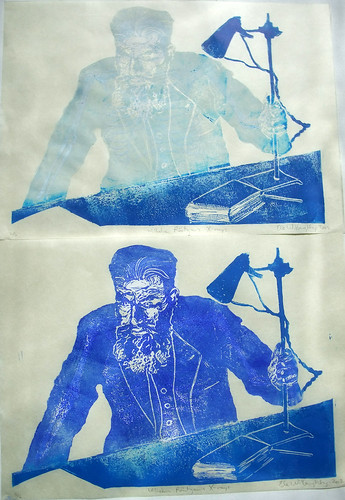
*Physics has the best words. Also, all my knowledge of German comes from physics, chemistry or music, which makes for an odd, and not particularly useful assortment. Bremsstrahlung, Gedankenexperiment, mit Ausdruck, Dur, Moll...
Labels:
art about science,
history of physics,
history of science,
linoleum,
minouette,
printmaking,
radiology,
thermochromic,
Wilhelm Roentgen,
x-rays
Monday, April 2, 2012
Reading is sexy XLIX
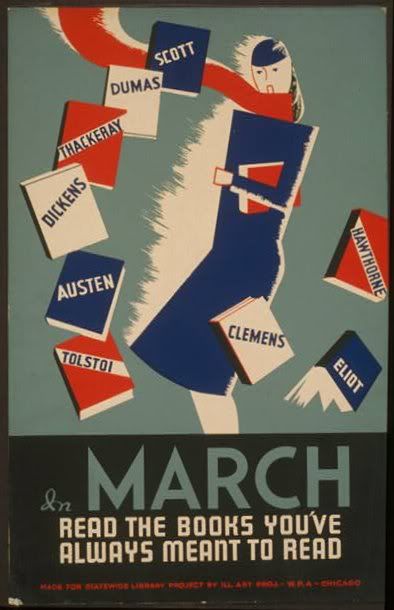 (image: 'In March read the books you've always meant to read' via brainpickings March 25, 1941, WPA Art Project Chicago)
(image: 'In March read the books you've always meant to read' via brainpickings March 25, 1941, WPA Art Project Chicago)I think it's official. I have reader's block. It's like writer's block, but for readers. I have been a roughly a book a week (40 to 50 a year) sort of reader for the last couple of decades (oh, dear, how is that possible?)... but not of late. I barely read 25.5 books last year, and this year is not off to an auspicious start. I think trying to read 'Myths to Live By' was one of my mistakes.
1. Myths to Live By by Joseph Campbell. I pulled this book off RJH's shelf and it nearly did me in. I thought, "It's Joseph Campbell, on myths, how can I go wrong?" I was wrong. It took me the better part of 4 months to read this book. It did not resonate with me. I suspect, as Faunalia suggested, that was because the ideas were not new to me, though they would have seemed far more so had I read it when it was published (which, for the record, would be before my birth - I'm not that old). In fact, in December, I was waiting for the streetcar at Queen and Ossington with F., ranting about my attempt to read this book*, and I was shaking it about, asking "It's Joseph Campbell, on myths, I thought how could I go wrong?" when a lovely lady who had been in our screenprinting class in the fall, coincidentally walked by and said, "Oh hello! How are you? That's my favorite book!" I could only be thankful that she interrupted me before I launched into my attack. While there was interesting information in this book, I found it dated. I was impatient with the asides of "Kids these days!" (these days being the late 60s) and was surprised at his attitudes towards the religious (in sum, they are immature). I'm not religious and that irked me. Also, I know enough geochronology to know his allusions to prehistoric anthropology are out of date. There might be an interesting book in linking schizophrenia to the hero's quest, but this is not that book. Mainly, I learned some things about yoga, and read a bunch of things I had read before. If you are interested in the history of the study of myth, maybe this is the thing. Or maybe the trick is to read a single lecture at a time. I personally think if you are actually looking for myths to live by, you might be better off reading Women who run with the wolves. Or maybe, I've become a cranky reader.
2. Pattern Recognition by William Gibson. I read this book because Faunalia got tired of recommending I pick it up 200 times and she bought me a paperback copy. I hadn't read any Gibson in years, though I enjoyed Neuromancer and so forth, in my early 20s. This is the story of Cayce Pollard, cool hunter in 2003, charged with finding the source of "the footage", a sort of cult film released anonymously in tiny portions in random places on the internet and obsessively collected by an on-line community of footageheads. Cayce is haunted by the memory of her father, who went missing in Lower Manhattan on September 11, 2001. Cayce's success as a cool hunter is attributed to a sort of allergy to branding. It's a fascinating premise and Gibson translates his cultural exposition and critique from cyberpunk to the contemporary world with great success. The novel works as a sort of thriller, with some well-written characters. She travels the world chasing the source of the footage, trying to tell friend from foe, and finding the place where marketing meets globalization and terror. I was annoyed that she used Hotmail (really, a cool hunter would use something so desperately uncool, in 2003?) and I was a bit disappointed in the denouement. After reading an engaging and innovative novel, I expected a bit more than an Agatha Christie-style "let's contrive to have all the characters have dinner and explain all the missing bits" with a series of letters back and forth to tie up all the loose ends. However, the reason this annoyed me was that the novel was very good indeed up to that point. I do recommend it.
3. The Sense of an Ending by Julian Barnes. Don't say I didn't warn you that I've been a cranky reader of late, but I expected a bit more from the Man Booker prize winner. This is a good novel, but I wasn't amazed or truly moved. The novel is told in two parts. Tony Webster and his clique at school meet Adrian Finn and vie for his attention. They are pretentious, adolescent boys, who think highly of their own wit and intelligence, and sense that Finn is perhaps more genuine and clever. In the second part he he's retired, after a calm life, career, marriage and divorce (though he still has cozy little lunches with his ex-wife). An unexpected lawyer's letter brings back that adolescent through college years, his girlfriend of the time and his friend Finn. He remembers and slowly learns how the past is not always what we thought. I think the story would have affected me more had I liked Tony Webster.
4. Vintage Lopez by Barry Lopez. I stumbled upon this book and liked the sound of an explorer who had worked extensively in the Arctic. This collection includes non-fiction essays investigating the relationship between literature and landscape, ecology, light, and how air freight works (which is more interesting that it sounds). He has a way of painting indelible images in my mind. I really enjoyed the short fiction written at the intersection of art and science (imaginary anthropology, collectors and naturalists but most particularly the mapmaker). I wish I were the sort of person who could have written The Mappist. He manages to make an obsessive quest to map everything in North Dakota (geology, hydrology, biology, botany, history of the place form Native times, including paths flown by Swainson's hawks, and their principle prey ground squirrels, types of soil in transparent overlays, all footpaths and their history, and so forth) sound downright magical, and the sort of things which would have been in Borges' library.
*I care enough about books to discuss them in a heated fashion while flinging the book about... or something like that.
{Series so far: books read, more books read, books read, books read continues, more books read, I, II, III, IV, V, VI, VII, VIII, IX, X, XI, XII, XIII, XIV, XV, XVI, XVII, XVIII,XIX, XX, XXI, XXII, XXIII XXIV, XXV, XXVI, XXVII, XXVIII, XXIX, XXX, XXXI, XXXII, XXXIII, XXXIV, XXXV, XXXVI, XXXVII, XXXVIII, XXXIX, XL,XLI, XLII, XLIII,XLIV, XLV, XLVI, XLVII, XLVIII}
Subscribe to:
Posts (Atom)









